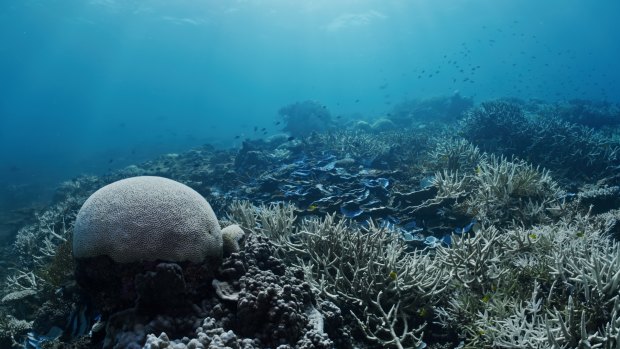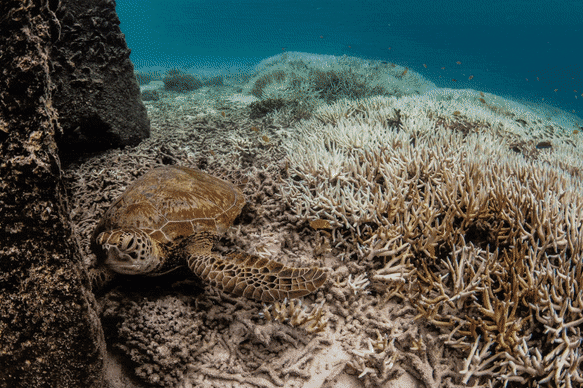This was published 1 year ago
Unprecedented spread of coral bleaching along Great Barrier Reef
By Mike Foley
Three quarters of the Great Barrier Reef has been hit in a widespread coral bleaching sparked by a marine heatwave, with aerial survey results revealing a major bleaching event is unfolding all the way along the 2300 kilometre ecosystem.
The world is now on the precipice of a global bleaching event, which is expected to be announced following these survey results.

Coral bleaching on the southern Great Barrier Reef.Credit: Grumpy Turtle Designs / Australian Marine Conservation Society
Global warming is an existential threat to all coral reefs, driving more frequent and intense marine heatwaves.
“It’s alarming how extensive and severe this current coral bleaching event is,” said Australian Marine Conservation Society reef campaign manager Lissa Schindler.
Bleaching on the Reef was first detected a month ago, but aerial surveys conducted by the Great Barrier Reef Marine Park Authority – released on Friday night – show that 75 per cent of 1001 reefs inspected contain bleached corals, which means the organisms are struggling to survive.
The survey included reefs in the Torres Strait, where bleaching was not as widespread compared with mainland Australia’s coastline.
The US National Oceanic and Atmospheric Administration said a global event was looming due to widespread bleaching on many of the northern hemisphere’s coral reefs over the past year, combined with the likelihood of widespread bleaching in the southern hemisphere.
Bleaching is categorised by the proportion of reefs in a region that display signs of distress.
Half of the Great Barrier Reef has been hit by high to very high bleaching, the new aerial surveys found, with and 10 per cent classed as extreme bleaching – when more than 90 per cent of corals are distressed.
Aerial surveys are conducted by sight from planes at 500 feet, giving the visibility of corals down to about five metres below the sea surface.

Coral bleaching on the southern Great Barrier Reef.Credit: @theundertow.ocean & diversforclimate
The more bleached corals, the higher the risk of deaths. But bleaching is not always fatal and corals can recover if the water cools down quickly enough.
Aerial surveys cannot determine the death rate. Underwater surveys are underway now to determine mortality from the current bleaching event.
WWF Australia head of oceans Richard Leck said the survey results indicated the bleaching event hit all three regions of the reef – north, central and south – which would be unprecented in scale.
“Previous bleaching events have crossed into two of the reef regions and that’s usually been the north and the central regions,” Leck said.
Australia’s climate has already warmed by an average of 1.47 degrees over the past century, according to the Bureau of Meteorology. A report by the Australian Academy of Science said if the world warmed by 2 degrees, only 1 per cent of corals would survive.
The Albanese government’s target to cut national emissions by 43 per cent by 2030 and reach net zero by 2050 is consistent with international efforts that would lead to 2 degrees or more of warming.
Mass coral bleaching events have occurred on the Great Barrier Reef in 1998, 2002, 2016, 2017, 2020, 2022 and now 2024.
UNESCO has said Australia must demonstrate that the Great Barrier Reef should not be listed as “in danger” – and risk losing its World Hertiage status – at a meeting in July.
Australia has argued it is making sufficient gains on climate action and environmental actions. The government’s special envoy for the Great Barrier Reef, Nita Green, recently went to UNESCO headquarters in Paris with marine park authority chief executive Josh Thomas to make this argument.
“As special envoy for the Great Barrier Reef I work with all parties who are committed to the health of the Reef, that includes meeting with UNESCO on the ongoing health, protection and management of our precious World Heritage site.”
Greens oceans spokesperson Peter Whish-Wilson accused the federal government of attempting to “deliberately deceiving the world” about the severity of climate change impacts on the reef.
“It’s time for no more spin, deceit and distractions. The Greens are calling for full transparency of any recent lobbying of UNESCO by the Albanese government,” Whish-Wilson said.
Federal Environment Minister Tanya Plibersek said the government had boosted Australia’s climate target since its 2023 election win and was committed to improving reef health.
“We know the biggest threat to coral reefs worldwide is climate change. The Great Barrier Reef is no exception,” Plibersek said.
We’ve legislated to reach net zero, with a 43 per cent emissions reduction target by 2030 and committed to reaching 82 per cent renewable energy by 2030. And we’re investing a record $1.2 billion in the Reef including to ensure we have the best science on reef adaptation and resilience.”
Senator Green said her role includes meeting with UNESCO to discuss management of the World Heritage listed ecosystem.
“As Special Envoy for the Great Barrier Reef I work with all parties who are committed to the health of the reef,” she said.
Get to the heart of what’s happening with climate change and the environment. Sign up for our fortnightly Environment newsletter.